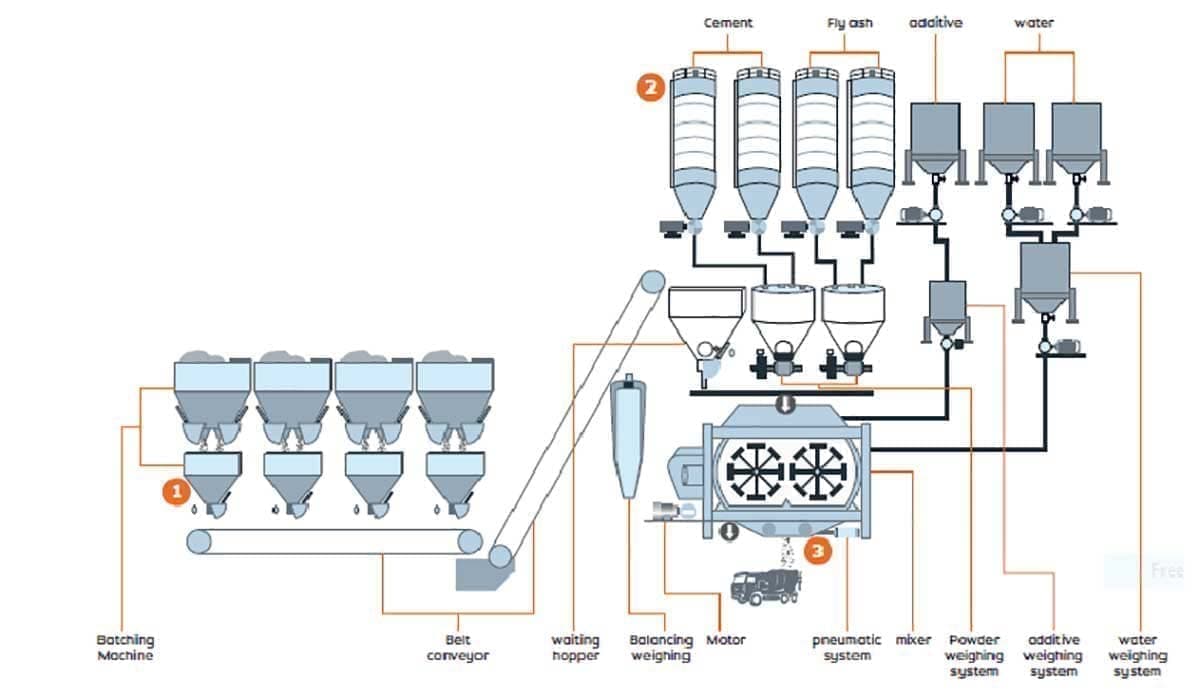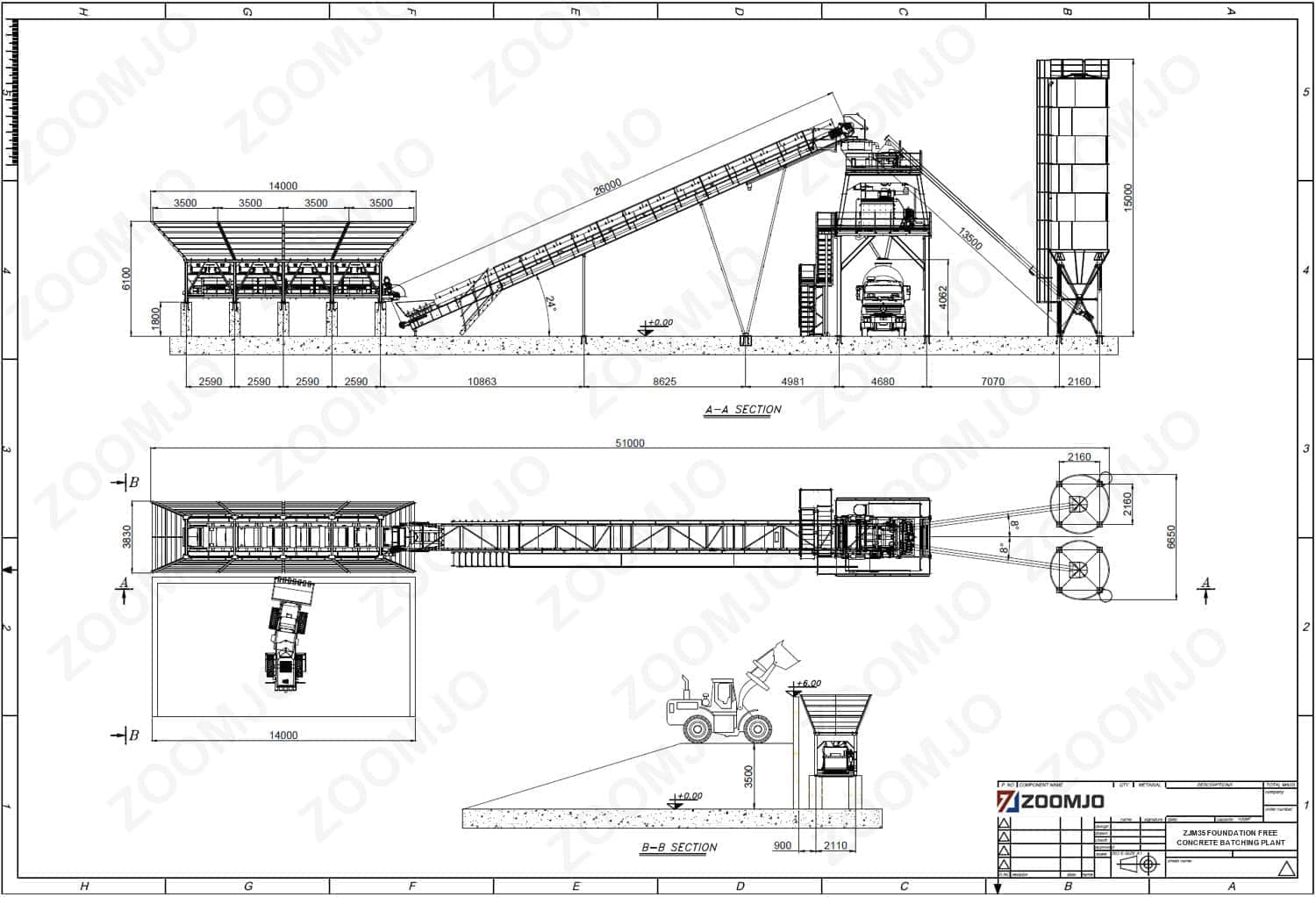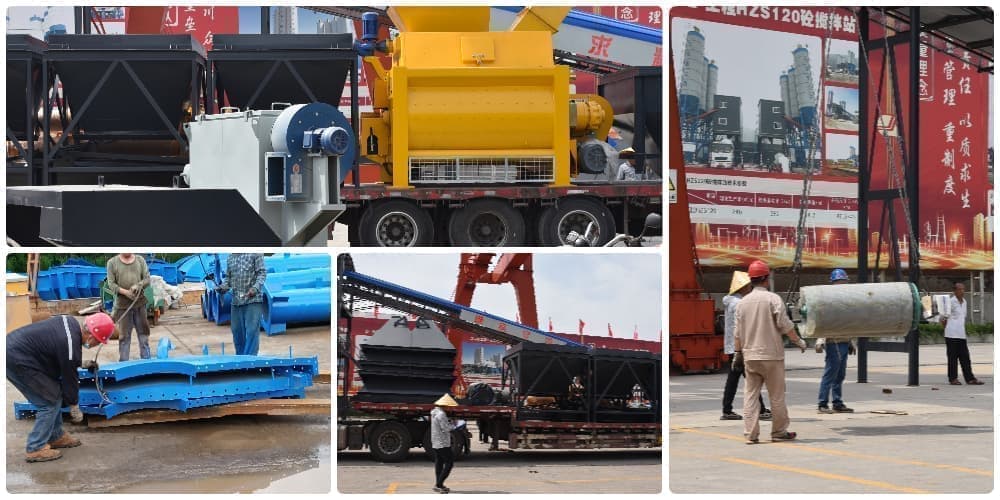Buyer's Guide to Automatic Concrete Batching Plants in Ukraine

The Ukrainian construction equipment market, affected by the current situation, is experiencing significant changes. The market for automatic concrete mixing plants, an important piece of equipment for infrastructure construction, has changed accordingly. This article will analyse the current market situation, equipment characteristics, market value, and potential business opportunities and challenges of automatic concrete mixing plants in Ukraine for related companies.
Current Situation of Automatic Concrete Batching Plant Market in Ukraine
The automatic concrete mixing plant market in Ukraine is experiencing significant changes in the current situation. Changes in the demand for infrastructure development and reconstruction are having a direct impact on the market.
Overview of the current market situation
-
Equipment Availability & Adjustment: Due to changes in project schedules, some automated concrete mixing plants that were originally used for the project in question may face reconfiguration. Equipment owners may adjust to the new requirements, for example by seeking leases or transfers.
-
Market Demand Adjustment: In addition to the traditional construction sector, reconstruction and rehabilitation work is creating a new demand for concrete, which is driving potential demand changes in the mixing plant market.
-
Price Factors: Factors such as market supply and demand, equipment condition, and transport costs may affect the price of a mixing plant.
-
Changes in Market Players: Changes in the market environment may lead to adjustments in the strategies of some of the existing players and may also provide opportunities for new market players.
The Ukrainian automatic concrete mixing plant market is characterised by dynamic changes under the influence of the current situation. For companies interested in entering this market, it is important to focus on the business opportunities involved, but also to be fully aware of the challenges that exist. Success in the market can only be achieved by seizing the opportunities and addressing the challenges through in-depth market analysis and assessment.
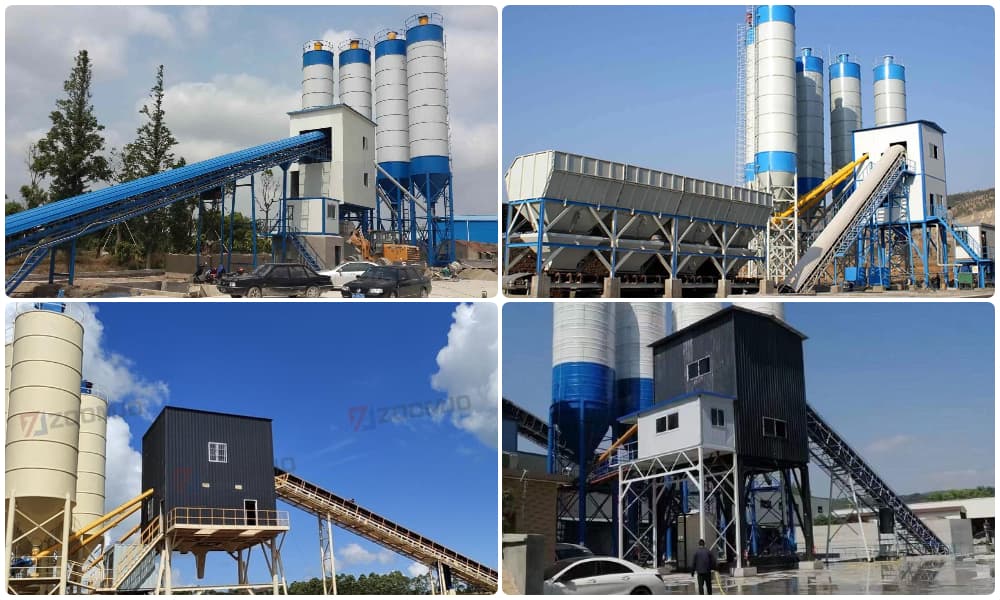
Overview of Automatic Concrete Batching Plants
As an experienced professional in the field of construction innovation, I have had the privilege of witnessing the transformative impact of Ukrainian automatic concrete mixing plants in the global market. These plants have revolutionised the concrete production industry with their efficiency, precision and reliability, making them an indispensable technology for large-scale projects.
What is an automatic concrete mixing plant?
Automatic Concrete Batching Plant is an efficient automated equipment used for mass production of concrete. It mixes raw materials such as cement, sand, stone and water in specific proportions through a series of processes such as precise weighing, conveying and mixing to produce high-quality concrete that meets the requirements of the project.

Working Principle
Automatic Concrete Batching Plant utilises advanced technology, including Programmable Logic Controller (PLC), to automate the entire batching process. Specifically: Automatic Concrete Batching Plant is a set of highly intelligent equipment, which realises precise, efficient and stable concrete production process through advanced automation control system.
-
Accurate Batching: The mixing plant adopts high-precision sensors to monitor all kinds of raw materials in real time and weighs them accurately by means of electronic scales and other equipments to ensure that the amount of each material put in is strictly in accordance with the formula, so as to realise precise control of the concrete proportion.
-
Intelligent Conveying: After weighing the raw materials, an automatic conveying system is used to convey the materials to the concrete mixer accurately. The system usually adopts belt conveyor, screw conveyor and other equipment to ensure the continuity and stability of the material conveying process, which reduces manual intervention and improves the production efficiency.
-
High-efficiency mixing: The mixing plant is equipped with a high-efficiency forced mixer with multiple mixing blades inside, which generates strong shear force and mixing force through high-speed rotation, and mixes raw materials such as cement, water, sand and stone together quickly and evenly to ensure that the quality of concrete meets the design requirements.
-
Automatic control: The whole mixing process is automatically controlled by programmable logic controller (PLC), which can automatically control the operation of each link according to the preset formula and process parameters, realising the automation and intelligence of the production process.
Advantages
-
Reduced manual intervention: Through fully automated operation, the dependence on manual labour is minimized and the production efficiency is improved.
-
Increased productivity: fast and precise batching and mixing processes allow for a significant increase in concrete production capacity, adapting to the demands of large-scale construction.
-
Consistency and quality control: the automated system ensures consistency from batch to batch, meeting exacting engineering standards.
-
User-friendly interfaces: Many modern batching plants are equipped with touch-screen interfaces that allow users to select pre-programmed formulas, adjust batch sizes and monitor production in real time.
What are the main components of an automatic concrete batching plant?
The ability of an automatic concrete batching plant to produce high quality concrete with efficiency and precision is due to the synergy of several key components that work together to ensure automation, continuity and stability of the production process. Below is a detailed description of these core components:
1. Aggregate batching system
-
Components: Includes the aggregate silo (or hopper), the weighing system (usually electronic or belt scales) and the conveying system (e.g. belt conveyor or inclined chute).
-
Function: Responsible for storing, measuring and conveying different types of aggregates, such as sand, gravel, crushed stone etc. Aggregate silos are usually segregated according to the type and grain size of the aggregate. The weighing system ensures that the amount of each type of aggregate is accurately measured according to a preset ratio. A conveying system transports the measured aggregates to the mixer.
2. Cement and powder silos and conveying systems
-
Composition: Including cement silo, fly ash silo (or other mixer silo), screw conveyor, weighing system and dust removal system.
-
Function: Storing cement and various powdery admixtures, such as fly ash and slag powder. Screw conveyor transports cement and powder from silo to weighing system, which is accurately measured and transported to the mixer. Dust removal system is used to reduce dust pollution.
3. Mixing system
-
Composition: Including mixing machine (usually double horizontal shaft forced mixer or planetary mixer) and driving device.
-
Function: Mix the measured aggregate, cement, water and additives thoroughly to make a uniform concrete mixture. Compulsory mixer has the advantages of high mixing efficiency and homogeneous mixing, which is suitable for the production of various kinds of concrete.
4. Water and admixture weighing and supply systems
-
Components: Includes water tank, water pump, flow meter or water weighing hopper, admixture storage tank, metering pump and pipework.
-
Function: Accurately measure the amount of water and various admixtures (such as water reducer, retarder, early strength agent, etc.) required for concrete, and deliver them to the mixer by pump or gravity.
5. Control system
-
Composition: including programmable logic controller (PLC), industrial control machine, sensors, control cabinets and operator interface.
-
Function: It is the core of the batching plant, responsible for the automatic control of the whole production process, including material batching, mixing, unloading, etc. The control system can realise the functions of recipe management, data monitoring, trouble shooting and report generation. The control system can realise the functions of recipe management, data monitoring, fault diagnosis and report generation to improve the production efficiency and quality control level.
6. Conveying system (materials and finished products)
-
Composition: Including belt conveyor, inclined chute, elevator, hopper and so on.
-
Function: Used for conveying materials between components and conveying the mixed concrete to transport vehicles (e.g. concrete mixer trucks).
7. Environmental protection system
-
Components: Including dust collector, sewage treatment system, noise reduction equipment and so on.
-
Function: Reduce the dust, waste water and noise pollution generated in the production process, in line with environmental protection requirements.
8. Pneumatic system
-
Composition: Including air compressor, air tank, pneumatic valve and air pipe.
-
Function: Provide power for all kinds of pneumatic components of batching station, such as opening and closing of pneumatic valves and controlling pneumatic discharge gate.
The above components cooperate with each other to form an efficient and intelligent automatic concrete batching plant. Modern automatic concrete batching plant not only improves the production efficiency and quality of concrete, but also reduces the labour cost and environmental pollution, which is an important guarantee for modern construction projects.
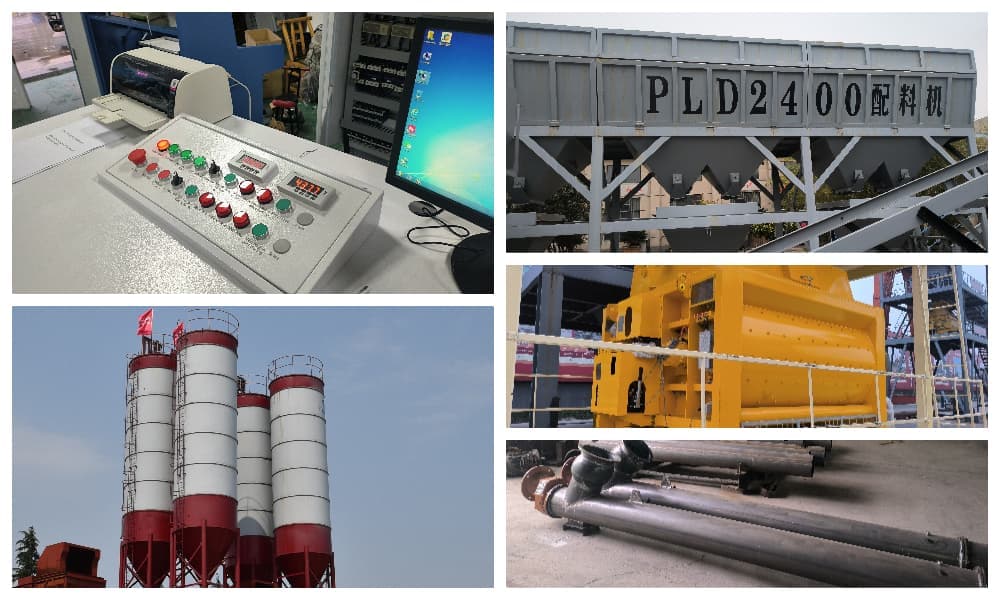
Common types of automatic concrete batching plant
Automatic concrete batching plant can be divided into the following main types according to its structure form and application scenarios:
Stationary concrete batching plant
Characteristics: Fixedly installed at a specific location, usually used for large-scale or long-term construction projects, such as bridges, dams, high-rise buildings, etc.
Advantages: Large production capacity, high degree of automation, high metering precision, good reliability, can be customised according to the project needs, such as increasing the number of aggregate silos, replacing the mixing mainframe with a larger capacity. It is suitable for the production of high-volume, high-strength and high-performance concrete.
Classification (according to the feeding method)
Belt feeding type: Aggregate is transported to mixer through belt conveyor, which has the advantages of large conveying capacity and high efficiency, and is suitable for large batching plant.
Hopper feeding: Aggregate is loaded into the hopper by loader or other equipment, and then lifted to the mixer, with relatively simple structure and low cost, suitable for small and medium-sized batching plant.
HZS series concrete mixing plant is a common stationary concrete batching plant, and its model is named by the theoretical production capacity per hour, and the unit is cubic metre. For example, HZS25 indicates that the theoretical production capacity is 25 cubic metres per hour. Other common models are HZS35, HZS50, HZS60, HZS75, HZS90, HZS120 and HZS180.
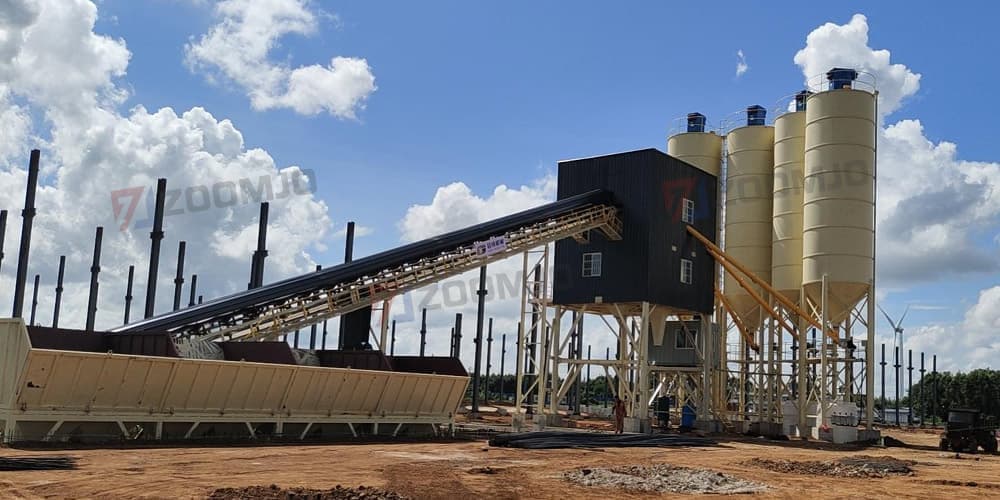
Mobile Mixing Plant
Features: The batching, mixing and control systems are integrated in one or several movable chassis, which can be easily transferred to different construction sites.
Advantage: Strong mobility, easy and quick installation and dismantling, reducing transport cost and time, especially suitable for small and medium-sized projects with short construction period and scattered sites, as well as concrete supply in remote areas or emergency projects.
Classification (according to the way of moving):
Trailer: mainly moved by trailer traction, slower moving speed, but good integrity, easy to quickly assemble and put into use.
Vehicle-mounted: The dosage system is mounted on the chassis of a truck, which is flexible and can be driven to the construction site directly, which is more convenient.
Common mobile concrete mixing plants include YHZS series, which highly integrates material storage, weighing, conveying, mixing, discharging and full-automatic control system on a semi-trailer unit with the advantages of compact structure and good mobility, and is commonly used for mobile construction of highways, bridges and other projects. Its models are named by the theoretical production capacity per hour (cubic metre), such as YHZS25, YHZS35, YHZS50, YHZS60, YHZS75, etc.
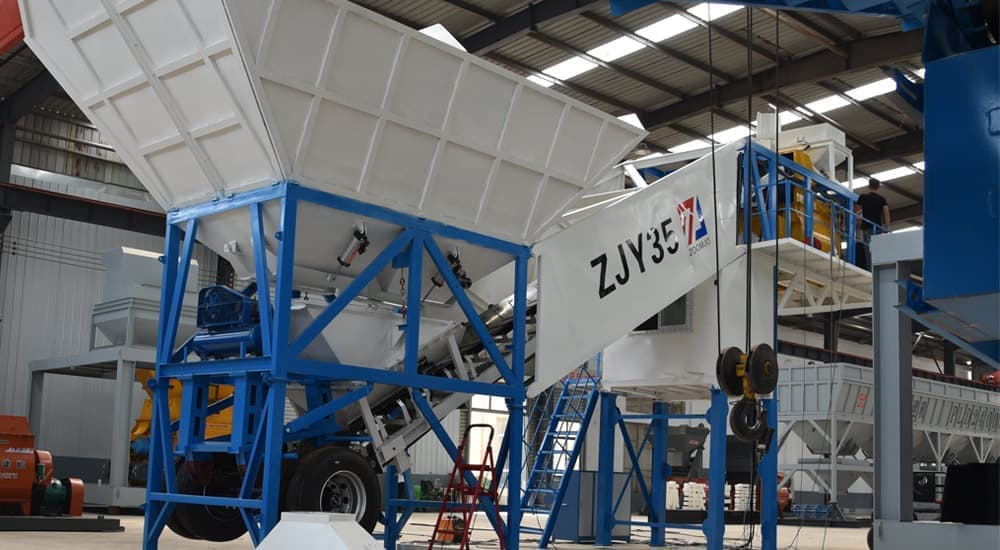
Compact Mixing Plant
Characteristics: Compact design, small footprint, simple structure, often with components integrated into a single frame.
Advantages: Low investment cost, quick installation, simple operation, suitable for urban construction sites with limited space, small-scale projects as well as self-consumption concrete production in rural or remote areas.
Application Scenario: Rural housing construction, small road repair, municipal engineering, etc.
Difference with mobile batching plant: Although both of them have certain mobility, compact batching plant usually does not have complete transport chassis and quick transfer ability like mobile batching plant, and more consideration is given to flexible arrangement in limited space.
4. Modular dosage stations
Characteristics: Breaking down the batching plant into several independent modules, such as aggregate batching module, cement batching module, mixing module, control module, etc.
Advantage: Easy to transport and install, can be flexibly combined and expanded according to the project needs, strong adaptability, can be used for small projects, but also can be expanded into a large-scale batching plant by adding modules.
Application Scenario: Special projects or projects that require frequent changes in production scale.
Summary and Comparison
| Type | Applicable Scenarios | Production capacity | Mobility | Investment cost |
|---|---|---|---|---|
| Stationary | Large, long-term project | large | poor | High |
| Mobile | Small and medium-sized, short-term, decentralised, emergency works | Medium | Good | Medium |
| Compact | Site constraints, minor works, self-use | Small | Better | Low |
| Modular | Special projects, projects requiring flexible expansion | Variable | General | Medium to high |
Factors to consider when buying a concrete batching plant in Ukraine
When buying a concrete batching plant in Ukraine, a number of factors need to be considered to ensure that the return on investment is maximised and construction needs are met. The following points have been optimised and supplemented to make the points you have provided more comprehensive and operational:
1. location and site requirements
-
Availability of raw materials: Examine the availability of raw materials such as sand, gravel, cement, water, etc., including sources, transport distances and costs to reduce production costs. Proximity to the source of raw materials can significantly reduce transport costs.
-
Transport conditions: Assess the distance and traffic conditions between the mixing plant and the construction site, including road quality, transport routes and traffic congestion. Convenient transport can ensure timely supply of concrete, reducing transport costs and time delays.
-
Site conditions: Assess the size of the installation site, geological conditions, water and electricity supply, and drainage system. The site should be level, solid, have sufficient load-bearing capacity, and be convenient for equipment installation and maintenance.
-
Environmental Protection Requirements: Understand local environmental regulations, including requirements for dust, noise, and wastewater discharge, and select equipment that meets the standards to avoid work stoppages or fines due to environmental issues.
2. Production capacity
-
Current project demand: According to the current project's concrete demand and construction progress, choose the appropriate mixing plant model and production capacity. Avoid choosing too big or too small equipment, resulting in waste of resources or oversupply.
-
Future development plan: Considering the future development plan of the enterprise and the potential project demand, choose the equipment with a certain degree of expandability and upgrading space to meet the future development needs.
-
Productivity and stability: Examine the productivity of the equipment, continuous work capacity and failure rate. Choose the equipment with stable performance and easy maintenance to improve production efficiency and reduce operating costs.
3. Technology and automation level
-
Control system: Select equipment equipped with advanced automation control system (e.g. PLC control system) to realise accurate batching, automated production and remote monitoring.
-
Measuring accuracy: Examine the measuring accuracy of materials such as aggregate, cement, water and additives to ensure stable quality of concrete.
-
Mixing technology: Select the appropriate type of mixing host (e.g., double horizontal shaft forced mixer) to meet the needs of different types of concrete production.
-
Troubleshooting and maintenance function: Select equipment with self-diagnosis of faults and remote maintenance function, so as to find and solve problems in time and reduce downtime.
4. Compliance with local regulations
Certifications and standards: Ensure that the equipment complies with the relevant Ukrainian safety standards and quality certifications for construction equipment.
Import and customs procedures: Understand Ukrainian import regulations and customs procedures to ensure smooth import and installation of the equipment.
5. Dealer reputation and support
-
Supplier qualification: Choose a reputable and experienced supplier who should have a professional sales team, technical team and after-sales service team.
-
After-sales service: Examine the supplier's after-sales service ability, including equipment installation and commissioning, operation training, maintenance and spare parts supply.
-
Localised service: Give priority to suppliers with branches or service centres in Ukraine or neighbouring regions, so as to obtain more timely and convenient localised service.
Leading Mixing Plant Manufacturers and Suppliers in Ukraine
The automated concrete mixing plant market in Ukraine is active with a number of well-known manufacturers and suppliers, who are highly regarded for their superior product quality, continuous innovation and deep understanding of diverse construction needs. Below are some of the major manufacturers that hold a significant position in the Ukrainian market and what makes them special in terms of products and technology:
1. ZOOMJO GROUP
ZOOMJO is a leading global manufacturer of construction machinery with an extensive product line of concrete mixing plants, covering a wide range of stationary, mobile, and construction mixing plants. ZOOMJO's products are known for their robust structure and excellent performance, and are capable of meeting the needs of various scales and types of construction tasks, including large-scale infrastructure projects.ZOOMJO has a deep accumulation of technology in the field of concrete machinery, and its products are outstanding in terms of reliability, durability and intelligence.
2. ELKON
ELKON is a Turkish manufacturer of concrete mixing plants, known for offering a diverse range of concrete batching plants, with a product line that covers compact, mobile and stationary mixing plants. Its plants feature advanced layout designs and energy-efficient systems with innovative automation technology to ensure precise control and high performance.ELKON focuses on modular design that can be customised to meet specific customer needs.
3. Liebherr
Liebherr is a globally renowned construction equipment manufacturer headquartered in Switzerland. Its ready-mixed concrete batching plants are known for their durability, reliability and technological advancement, and it has an extensive product line covering all types of mixing plants and concrete mixer trucks. Liebherr focuses on providing individual solutions for its customers and has a comprehensive global service network.
4. MEKA
MEKA is another concrete batching plant manufacturer from Turkey, offering a wide range of products from portable to large stationary, characterised by high efficiency and excellent performance.MEKA's plants are designed with a focus on practicality and maintenance, aiming to reduce the user's operating costs.
5. Eurotec
Eurotec is a European manufacturer of concrete mixing plants (specific countries need to be further confirmed), known for its innovative ready-mixed concrete batching plants, focusing on environmentally friendly design and modern technology, and committed to reducing its ecological impact. Its products are often modular in design and easy to install and maintain.
Other important considerations:
In addition to the above manufacturers, there may be other important local or international suppliers in the Ukrainian market. When selecting a supplier, the following factors should be considered in addition to brand and product quality:
-
Local service and support: It is important that the supplier has a well-established after-sales service network, spare parts supply and technical support team in Ukraine.
-
Price and payment options: Compare prices and payment options from different suppliers and choose the most suitable option.
-
Delivery time and logistics: Confirm the delivery time and mode of transport of the equipment to ensure that it arrives at the site on time.
-
Reputation and Cases: Find out what other users say about the supplier and their experience with it, as well as whether it has any successful cases in Ukraine.
By taking all these factors into consideration, you can choose the most suitable concrete mixing plant supplier in Ukraine to provide reliable guarantee for your construction project.
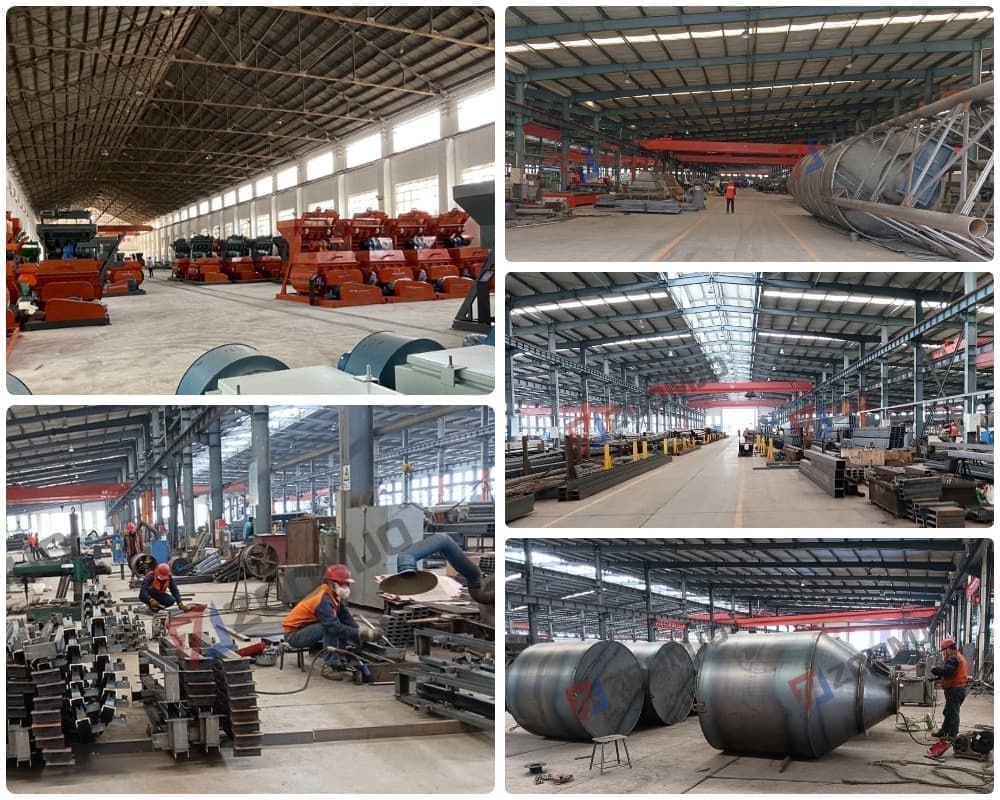
How much does it cost to build an automatic concrete batching plant?
The cost of an automatic concrete batching plant is a complex issue that is affected by a number of factors. Simply put, it can range from tens of thousands of dollars for a small mobile station to millions of dollars for a large stationary station. Below is a detailed analysis of the main factors that affect the cost of an automatic concrete batching plant and how to estimate the cost:
The main factors that affect the cost of an automatic concrete batching plant:
Production capacity
This is the most significant factor affecting the price. Production capacity is usually measured in concrete output per hour (cubic metres per hour). The higher the capacity, the larger and more complex the equipment required and therefore the higher the price. For example, a mobile station producing 25 cubic metres per hour is certainly much cheaper than a stationary station producing 120 cubic metres per hour.
Type
-
Fixed mixing plant: Usually used for large or long-term projects, with high production capacity, a high degree of automation and a relatively high price.
-
Mobile Batching Plant: Suitable for short-term or frequent change of location projects, high flexibility and relatively low price.
-
Compact Batching Plant: Small footprint, suitable for urban projects with limited space, moderate price.
-
Automation: The higher the degree of automation, such as more advanced PLC control system, more accurate metering system, more perfect monitoring system, the price will be increased accordingly. High degree of automation can improve production efficiency, reduce labour costs and error rate, but the initial investment is higher.
Configuration
-
Number and capacity of aggregate bins: The more aggregate bins and the larger capacity, the more types of aggregates can be stored to meet the needs of different ratios, but it will also increase the cost.
-
Type and quantity of mixing machine: Different types of mixing machine (such as double horizontal shaft forced, planetary, etc.) have different prices, and the quantity will also affect the total cost.
-
Conveyor system: The length, type and configuration of conveyor system, such as conveyor belt, elevator, etc. will also affect the price.
-
Measuring system: Accurate measuring system is crucial to ensure the quality of concrete, and the price of different types of measuring system varies greatly.
-
Admixtures: The type and quantity of admixtures will also affect the complexity and cost of the system.
-
Brands and Manufacturers: Prices for equipment vary widely by brand and manufacturer. Well-known brands are usually more expensive, but quality and after-sales service are more guaranteed.
-
Installation and commissioning: Installation and commissioning costs also need to be taken into account, including equipment transport, on-site installation, commissioning and training.
-
Geographic location: Factors such as labour costs, transport costs and taxes in different regions will also affect the total cost.
How to estimate the cost of automatic concrete batching plant?
-
Determine the project demand: Firstly, the concrete demand of the project, construction period and site conditions should be clarified in order to determine the required production capacity and mixing plant type.
-
Consult multiple suppliers: Consult multiple reputable suppliers to provide detailed project requirements and obtain quotation options.
-
Compare different proposals: carefully compare the quotation proposals of different suppliers, including equipment configuration, technical parameters, after-sales service, etc., and choose the proposal with the best cost performance.
-
Consider Total Cost of Ownership (TCO): Focus not only on the initial acquisition cost of the equipment, but also consider the operating cost, maintenance cost, energy consumption, etc., to assess the long-term economic performance of the equipment.
-
Refer to the industry average price: You can refer to the industry average price to make a preliminary judgement on the offer. However, it should be noted that the actual price will fluctuate depending on the specific configuration and market conditions.
Price range reference (for reference only, the actual price is subject to the supplier's offer):
-
Small mobile mixing plant (25-50 cubic metres/hour): several tens of thousands of US dollars to over one hundred thousand US dollars.
-
Medium-sized mobile mixing plant (50-100 cubic metres/hour): 100,000 US dollars to hundreds of thousands of US dollars.
-
Small stationary mixing plant (50-100 cubic metres/hour): several hundred thousand US dollars to one million US dollars.
-
Large stationary mixing plant (more than 100 cubic metres/hour): more than one million US dollars.
Contact concrete batching plant manufacturers for the latest concrete batching plant quotes!
Recommendation:
-
Conduct adequate market research and comparison before purchase.
-
Choose reputable suppliers to ensure equipment quality and after-sales service.
-
Communicate fully with suppliers to clarify project needs and technical requirements.
-
Sign a detailed contract to clarify the rights and obligations of both parties.
-
Hope the above information can help you better understand the cost of automatic concrete batching plant and make a wise purchase decision.
Maintenance tips for achieving optimum performance of automatic concrete batching plants
To ensure optimal performance of your automatic concrete batching plant, it is critical to perform routine evaluations and calibrations. This includes checking for wear and tear on all components such as the mixer, conveyor belt and control system. Frequent calibration of the weighing system is also required to maintain the accuracy of the active ingredient sizes to ensure consistent concrete quality.
Cleaning and lubrication
Routine cleaning of all parts of the plant must be carried out to avoid the build-up of concrete residue which can lead to mechanical failure. Mixers and discharge gates require special attention. In addition, lubrication of moving parts such as bearings and chains needs to be carried out regularly to minimise friction and prevent early wear.
Monitor and replace wear parts
It's important to keep track of problems with critical components such as belts, seals and pipes. These parts are subject to prolonged anxiety and can gradually deteriorate. Quickly replacing used or damaged components can prevent downtime and extend the life expectancy of your equipment. Keeping an inventory of commonly used extra components allows for quick fixes when needed.
Control System Updates and Backups
The control system is the brain of the automated concrete batching plant. Normal updates to the software increase capacity and safety. In addition, backing up control system information ensures that in the event of a system failure, operations can be resumed quickly and without serious disruption.
Training and safety protocols
It is important to ensure that all workers can effectively learn about plant operation and maintenance. Routine training sessions can reduce the threat of accidents and increase overall efficiency by keeping employees up-to-date on best practices as well as safety and security protocols. Implementing a comprehensive safety programme is important to protect both employees and equipment.
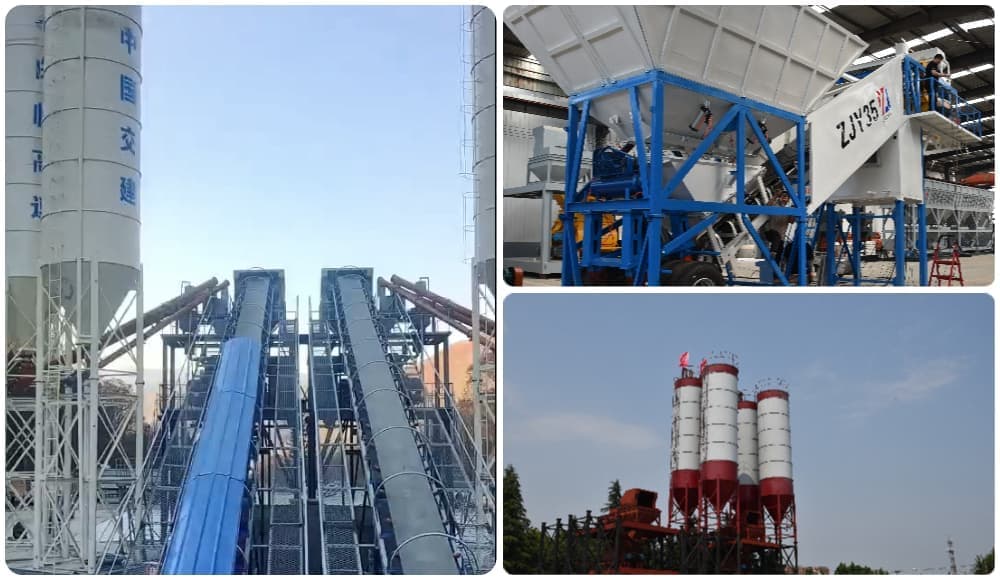
To summarise
In conclusion, the Ukrainian automatic concrete mixing plant market is facing many challenges but also contains great potential for growth. Only by fully understanding the market, carefully assessing the risks and adopting the right strategies can we seize the opportunities and succeed in this market full of changes. We hope that the information in this article can provide valuable reference and guidance for related enterprises.
Frequently asked questions about automatic concrete batching plant
Q: How do I choose the right concrete batching plant for my project?
A: Choosing a batching plant requires a combination of the following factors:
-
Concrete Demand: Based on the total concrete consumption and construction period of the project, calculate the required concrete production per hour or per day, so as to select the appropriate production capacity of the batching plant.
-
Project type: Different types of projects (e.g. highways, bridges, buildings, etc.) have different performance requirements for concrete, and need to choose the appropriate type and configuration of batching plant.
-
Site conditions: Evaluate the area of the installation site, geological conditions, water and electricity supply, etc., and select the appropriate type and layout of the batching plant.
-
Budget: Select the appropriate brand, model and configuration according to the budget, and consider the long-term operating cost of the equipment.
Q: What is the difference between fixed and mobile concrete batching plant? Which one should I choose?
A: The main difference is:
-
Fixed: Installed in a fixed location, large production capacity, high degree of automation, suitable for large or long-term projects.
-
Mobile: can be moved as a whole or split, high flexibility, suitable for short-term or need to frequently change the location of the project.
The choice depends on the specific needs of the project. If the project period is long, the concrete demand is large and the site is fixed, then choose the fixed type; if the project period is short and the location needs to be changed frequently, then choose the mobile type.
Q: Is it better to have more automation in a concrete batching plant?
A: Not absolutely. A high degree of automation can increase productivity, reduce labour costs and error rates, but the initial investment is higher. The right level of automation should be chosen by weighing the actual needs and budget of the project. For large, complex projects, high automation is necessary; for small projects, appropriate automation is sufficient.
Q: How to choose a reliable concrete batching plant supplier?
A: The following factors need to be considered when choosing a supplier:
-
Supplier qualification: Examine the supplier's production qualification, technical strength, industry experience and so on.
-
Product quality: Understand the supplier's product quality, technical parameters, user reputation.
-
After-sales service: Examining the supplier's after-sales service ability, including installation and commissioning, maintenance, spare parts supply, etc..
-
Localised service: Priority should be given to suppliers with branches or service centres in local or nearby areas in order to obtain more timely and convenient service.
Q: How to operate the concrete batching plant correctly?
A: The operator must be professionally trained and familiar with the structure, performance and operating procedures of the equipment. The operation process should be carried out in strict accordance with the operation manual, pay attention to safety matters, and do routine maintenance.
Q: How to ensure the batching accuracy of concrete batching plant?
A: The batching accuracy mainly depends on the accuracy of the metering system. High-precision sensors and meters should be selected and calibrated regularly. In addition, the operator should strictly follow the batching requirements and make records.
Q: What are the common faults of concrete batching plant? How to troubleshoot?
A: Common faults include:
-
Inaccurate weighing: Check transducers, gauges and dosing system for calibration or repair.
-
Aggregate conveying system failure: Check the conveyor belt, elevator and other components, repair or replacement.
-
Mixer failure: Check the motor, mixing shaft, blades and other parts, repair or replace.
-
Failure of air circuit system: check the air compressor, air pipe, valve and other parts, repair or replacement.
-
Control system failure: check PLC, sensors, wiring, etc., repair or replacement.
It is recommended to refer to the relevant troubleshooting manual, or contact the supplier's technical support.
Q: What are the wearing parts of concrete batching plant? How to replace them?
A: The wearing parts include:
-
Mixer blades and liners: Check the wear and tear regularly and replace them in time.
-
Conveyor belt: Check the wear and aging regularly and replace them in time.
-
Sensors and meters: Check the performance regularly and replace them in time if there is any abnormality.
-
Pneumatic components: Regularly check the sealing and working condition, if damaged, replace it.
-
Replacement of wearing parts should be carried out in accordance with the equipment manual, or ask a professional to carry out the replacement.

 English
English  Español
Español  简体中文
简体中文  Pусский
Pусский  українська
українська 